Lesson 03: Cracked


*Wear gloves during the entire process, as urushi can cause severe rash.
*We assume no responsibility for any health hazards.
1. Pouring raw urushi into cracks
A cracked pottery is repaired by pouring raw urushi into the cracks.
First, place a drop of raw urushi on the cracks inside the ceramics at equal intervals.
※Thin glazed vessels should be protected with masking tapes or use black urushi to fill in as in the Advanced tutorial.
Areas with deep cracks will quickly soak up the raw urushi, so place additional raw urushi on those areas.
Place raw urushi on only one side of the pottery and see how it goes.
By doing so, you will be able to see how far the urushi has soaked into the cracks.

If the other side of the crack is also brown, it can be considered that raw urushi has been firmly soaked into the crack.
If the other side is not browned, place raw urushi on the outside and allow it to soak in.
Leave the raw urushi for 15 minutes, and if no further signs of soaking are seen, wipe off the raw urushi with alcohol.
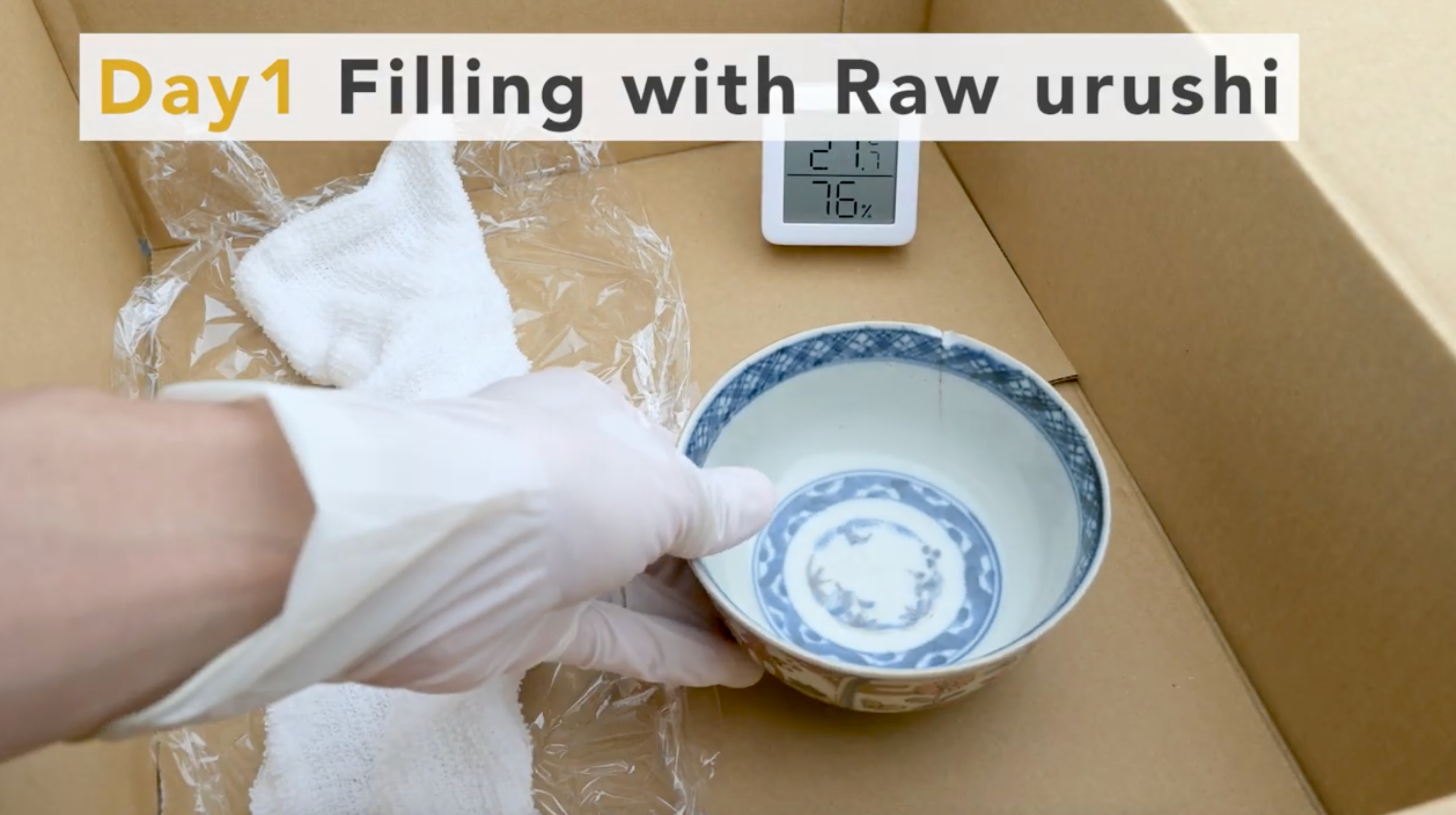
3. Wait about 1 week for the raw urushi to harden
The soaking process is complete.
Wait about one week for the raw urushi to harden.
Keep it in a place with a humidity of around 70% and a temperature of around 25 degrees Celsius.
- note
- One method is to place wet towels in cardboard boxes to maintain the right humidity for storage.
- The temperature should also be kept from getting cold by using air conditioning.
- In particular, urushi may not harden properly if the temperature falls below 20 degrees Celsius, so be careful to control both temperature and humidity after working on this and subsequent steps.
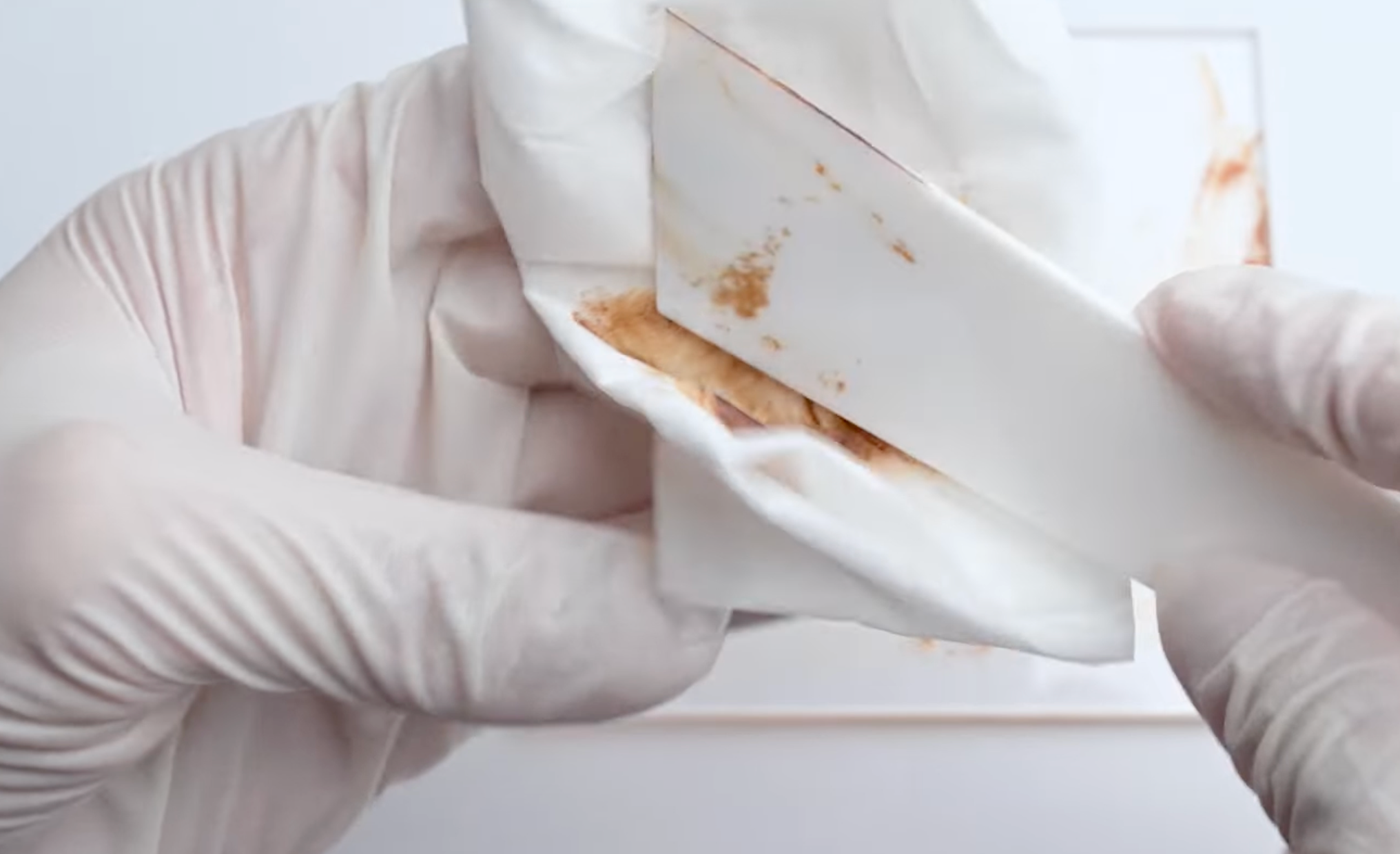
How to wash tools
Wipe off any tools with urushi using a tissue moistened with ethanol.
All tools except for the brush can be wiped off with ethanol.
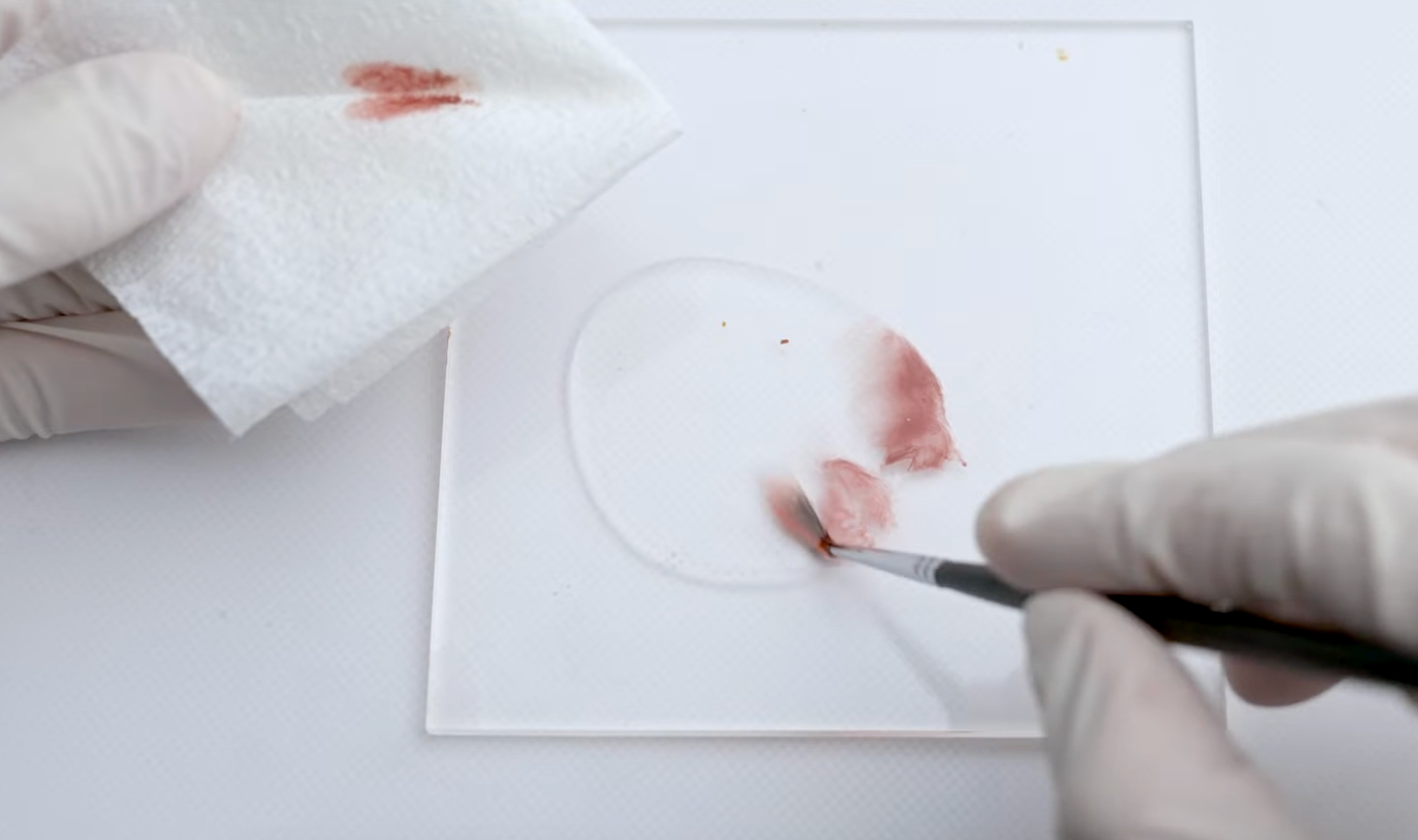
How to wash brushes
Wash brushes after use with vegetable oil such as rapeseed oil.
Dip the brush into the oil that has been put out on the acrylic plate and wipe it off with a tissue.
Repeat this process until there is almost no color on the tissue.
Finally, put the cap on and store the brush with a little oil remaining on it.
Otherwise, the brush tip may harden.
Finally, completely wipe off any oil remaining on the acrylic plate with ethanol.
If even a small amount of oil is left, it may mix with the oil and prevent the urushi from hardening next time.
*Wear gloves during the entire process, as urushi can cause severe rash.
*We assume no responsibility for any health hazards.
1. Pouring raw urushi into cracks
A cracked pottery is repaired by pouring raw urushi into the cracks.
First, place a drop of raw urushi on the cracks inside the ceramics at equal intervals.
※Thin glazed vessels should be protected with masking tapes or use black urushi to fill in as in the Advanced tutorial.
Areas with deep cracks will quickly soak up the raw urushi, so place additional raw urushi on those areas.
Place raw urushi on only one side of the pottery and see how it goes.
By doing so, you will be able to see how far the urushi has soaked into the cracks.
If the other side of the crack is also brown, it can be considered that raw urushi has been firmly soaked into the crack.
If the other side is not browned, place raw urushi on the outside and allow it to soak in.
Leave the raw urushi for 15 minutes, and if no further signs of soaking are seen, wipe off the raw urushi with alcohol.
3. Wait about 1 week for the raw urushi to harden
The soaking process is complete.
Wait about one week for the raw urushi to harden.
Keep it in a place with a humidity of around 70% and a temperature of around 25 degrees Celsius.
- note
- One method is to place wet towels in cardboard boxes to maintain the right humidity for storage.
- The temperature should also be kept from getting cold by using air conditioning.
- In particular, urushi may not harden properly if the temperature falls below 20 degrees Celsius, so be careful to control both temperature and humidity after working on this and subsequent steps.
How to wash tools
Wipe off any tools with urushi using a tissue moistened with ethanol.
All tools except for the brush can be wiped off with ethanol.
How to wash brushes
Wash brushes after use with vegetable oil such as rapeseed oil.
Dip the brush into the oil that has been put out on the acrylic plate and wipe it off with a tissue.
Repeat this process until there is almost no color on the tissue.
Finally, put the cap on and store the brush with a little oil remaining on it.
Otherwise, the brush tip may harden.
Finally, completely wipe off any oil remaining on the acrylic plate with ethanol.
If even a small amount of oil is left, it may mix with the oil and prevent the urushi from hardening next time.





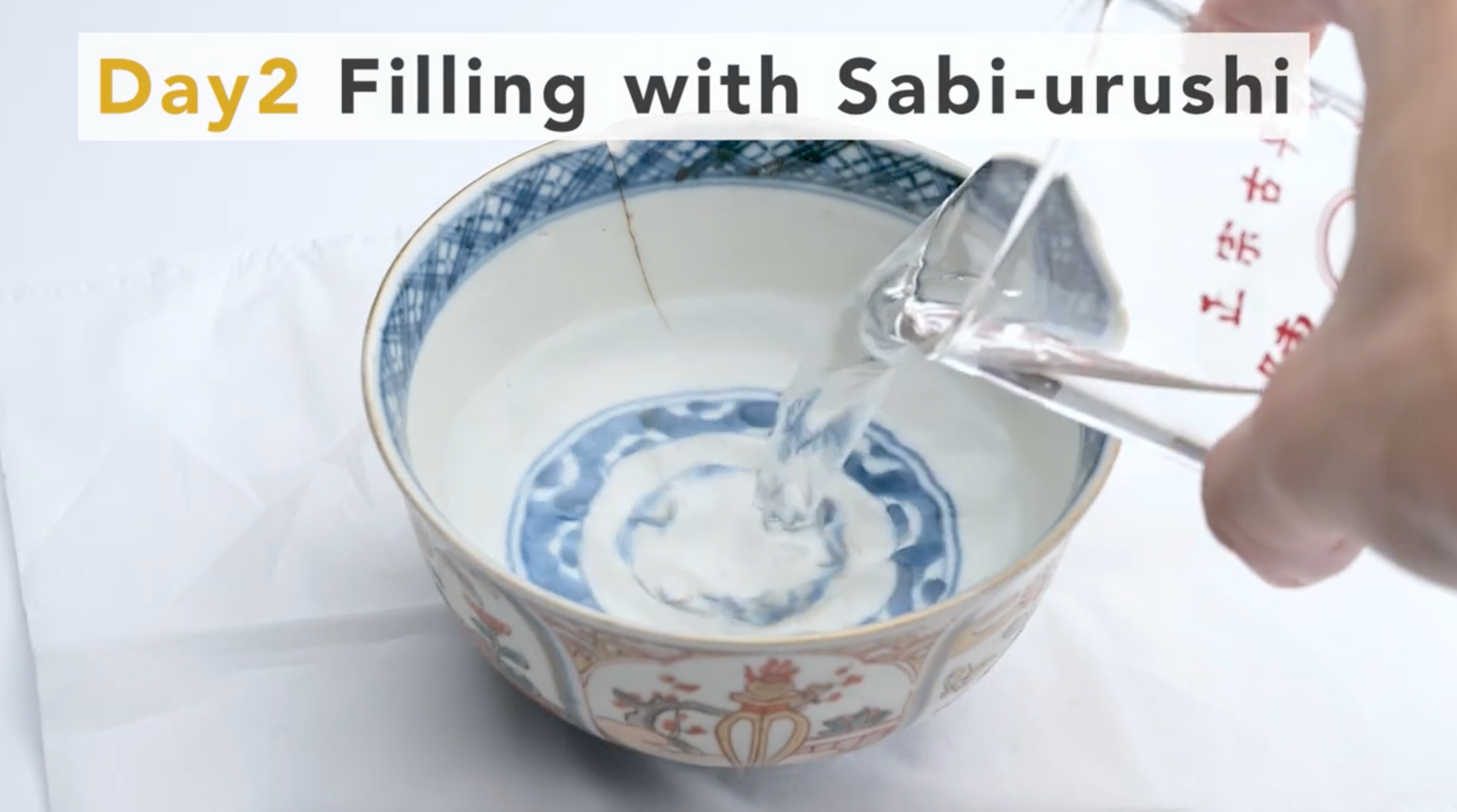
0. Check to see if the cracks are filled
Before starting Step2, pour water into the pottery and check for leaks.
If there are any leaks, do Step1 again and fill the leaking area with the raw urushi.

1. Make a groove with a cutter
Once the cracks are filled, use a cutter to make a groove.
Urushi does not stick well on glass and other smooth materials.
So, if the glaze is well glazed ceramics, coating with urushi at this point may cause the urushi to peel off easily.
The grooves make it difficult for urushi to peel off.
When making a groove, be aware that it should be wider rather than deeper.

2. Making "Sabi-urushi"
Once grooves are created, we will use "Sabi-urushi" to fill the seams.
- Ingredients for Sabi-Urushi
- Tonoko: 2 grated spoonful
- Water: 1 grated spoonful
- Raw urushi: 1 grated spoonful
- ※With 0.1ml measuring spoon
First, take Tonoko on an acrylic plate, add water and mix them.
Then, add raw urushi and knead with a spatula.
The sabi-urushi dries quickly, so make it as small as possible and place the spatula on top to keep it out of the air.
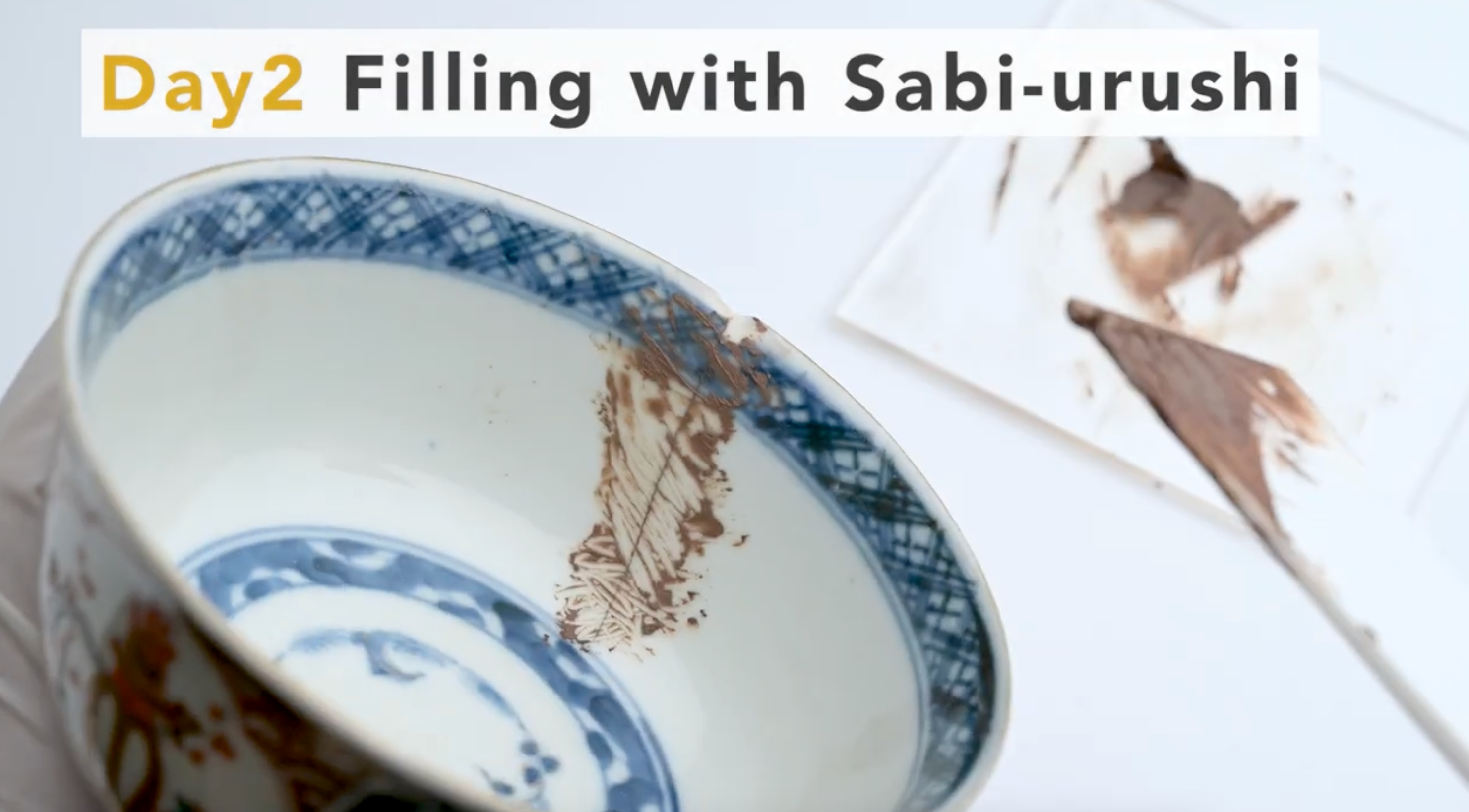
3. Apply sabi-urushi to the seams
Apply sabi-urushi to the grooves at the seams.
※Use masking tape to protect unglazed pottery from stains.
The purpose of this step is to flatten the seams of the ceramics.
So, apply it so that no grooves are left.
This porcelain had a small chip, so this was also filled in with it.
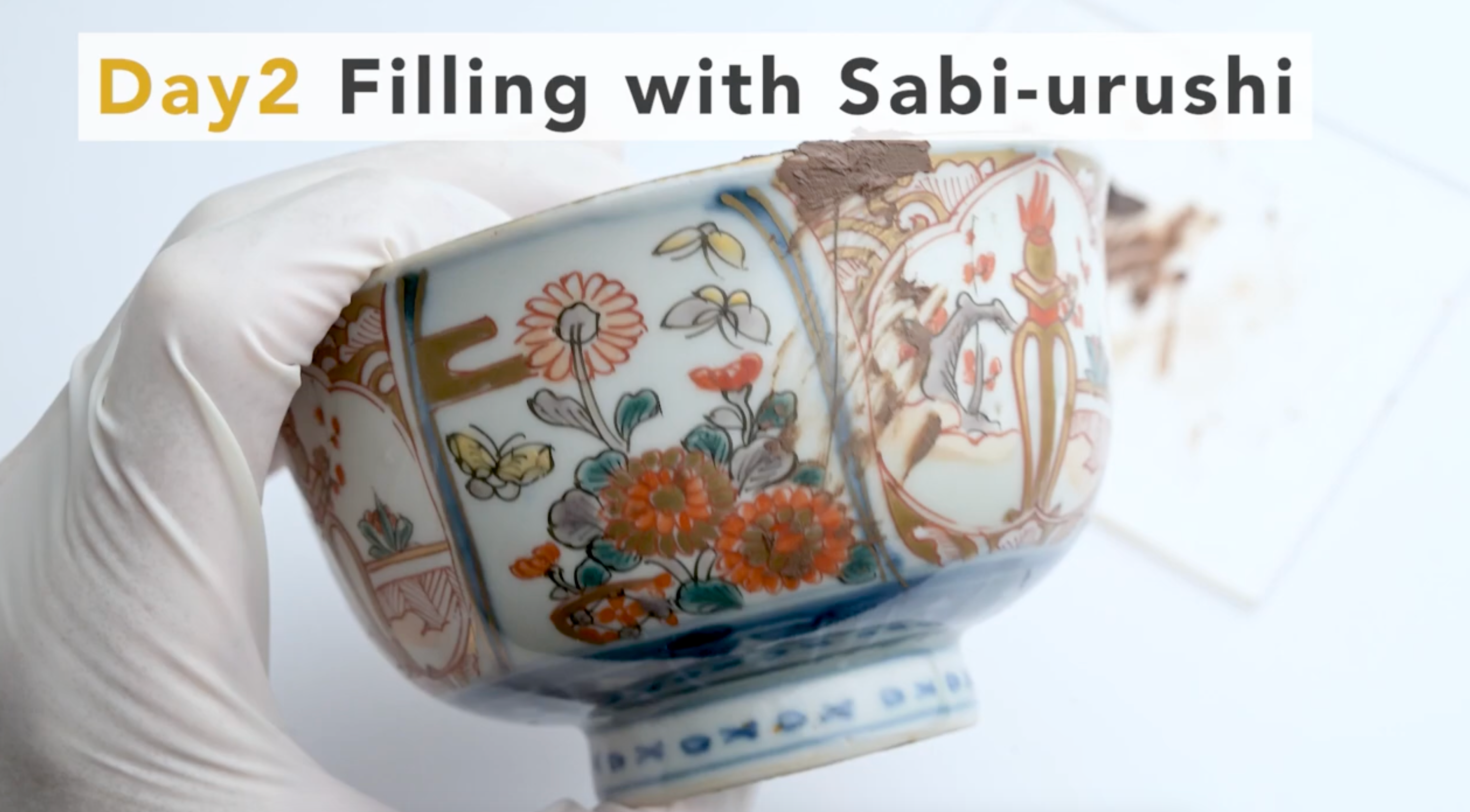
4. Wait a few days to harden
Wait a few days for the sabi-urushi to harden.
The sabi-urushi does not need much humidity to harden, but it may not harden sufficiently in dry areas, for example.
To be safe, keep it in a place with a humidity of around 70% and a temperature of around 25 degrees Celsius.
- Note
- If you try to fill large chips with sabi-urushi, only the surface of the sabi-urushi might dry, leaving the inside dull. If the groove is more than 1mm deep, use "Kokuso-urushi" used for chipped repair.
- note
- One method is to place wet towels in cardboard boxes to maintain the right humidity for storage.
- The temperature should also be kept from getting cold by using air conditioning.
- In particular, urushi may not harden properly if the temperature falls below 20 degrees Celsius, so be careful to control both temperature and humidity after working on this and subsequent steps.
0. Check to see if the cracks are filled
Before starting Step2, pour water into the pottery and check for leaks.
If there are any leaks, do Step1 again and fill the leaking area with the raw urushi.
1. Make a groove with a cutter
Once the cracks are filled, use a cutter to make a groove.
Urushi does not stick well on glass and other smooth materials.
So, if the glaze is well glazed ceramics, coating with urushi at this point may cause the urushi to peel off easily.
The grooves make it difficult for urushi to peel off.
When making a groove, be aware that it should be wider rather than deeper.
2. Making "Sabi-urushi"
Once grooves are created, we will use "Sabi-urushi" to fill the seams.
- Ingredients for Sabi-Urushi
- Tonoko: 2 grated spoonful
- Water: 1 grated spoonful
- Raw urushi: 1 grated spoonful
- ※With 0.1ml measuring spoon
First, take Tonoko on an acrylic plate, add water and mix them.
Then, add raw urushi and knead with a spatula.
The sabi-urushi dries quickly, so make it as small as possible and place the spatula on top to keep it out of the air.
3. Apply sabi-urushi to the seams
Apply sabi-urushi to the grooves at the seams.
※Use masking tape to protect unglazed pottery from stains.
The purpose of this step is to flatten the seams of the ceramics.
So, apply it so that no grooves are left.
This porcelain had a small chip, so this was also filled in with it.
4. Wait a few days to harden
Wait a few days for the sabi-urushi to harden.
The sabi-urushi does not need much humidity to harden, but it may not harden sufficiently in dry areas, for example.
To be safe, keep it in a place with a humidity of around 70% and a temperature of around 25 degrees Celsius.
- Note
- If you try to fill large chips with sabi-urushi, only the surface of the sabi-urushi might dry, leaving the inside dull. If the groove is more than 1mm deep, use "Kokuso-urushi" used for chipped repair.
- note
- One method is to place wet towels in cardboard boxes to maintain the right humidity for storage.
- The temperature should also be kept from getting cold by using air conditioning.
- In particular, urushi may not harden properly if the temperature falls below 20 degrees Celsius, so be careful to control both temperature and humidity after working on this and subsequent steps.





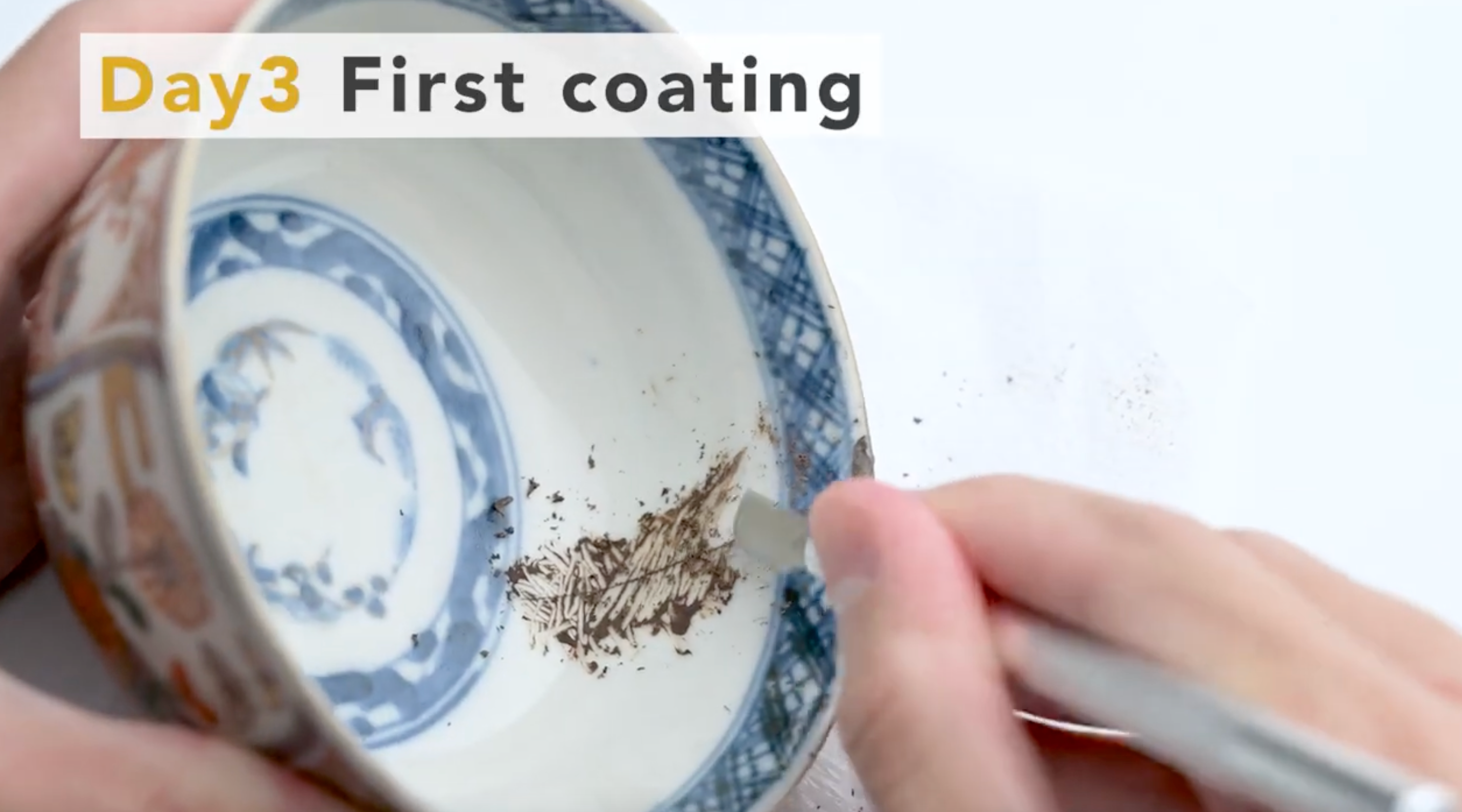
1. Scrape off the sabi-urushi
After the sabi-urushi has hardened, scrape off it on the overhangs with a cutter to make the seams flat and even.
If the chipped surface is large and difficult to smooth with a cutter, use a sandpaper to smooth the surface as much as possible.
Wipe off any dirt on the surface of the ceramics with an ethanol-soaked tissue as appropriate.

2. Coating the seams with "Bengara urushi"
Once the seams are flatten, coat the seams with "Bengara urushi".
Wipe the brush tip thoroughly with ethanol first before use.
It is recommended to apply the inside first because if you apply the outside first, you may touch the seam when applying the inside.
The purpose of this process is not to simply coat the seams, but to fill in the small dents by pouring bengara urushi into the seams to further flatten the surface.
Work as if you were "filling in the gaps with urushi" rather than "applying urushi".
Apply so that the surface is this smooth.
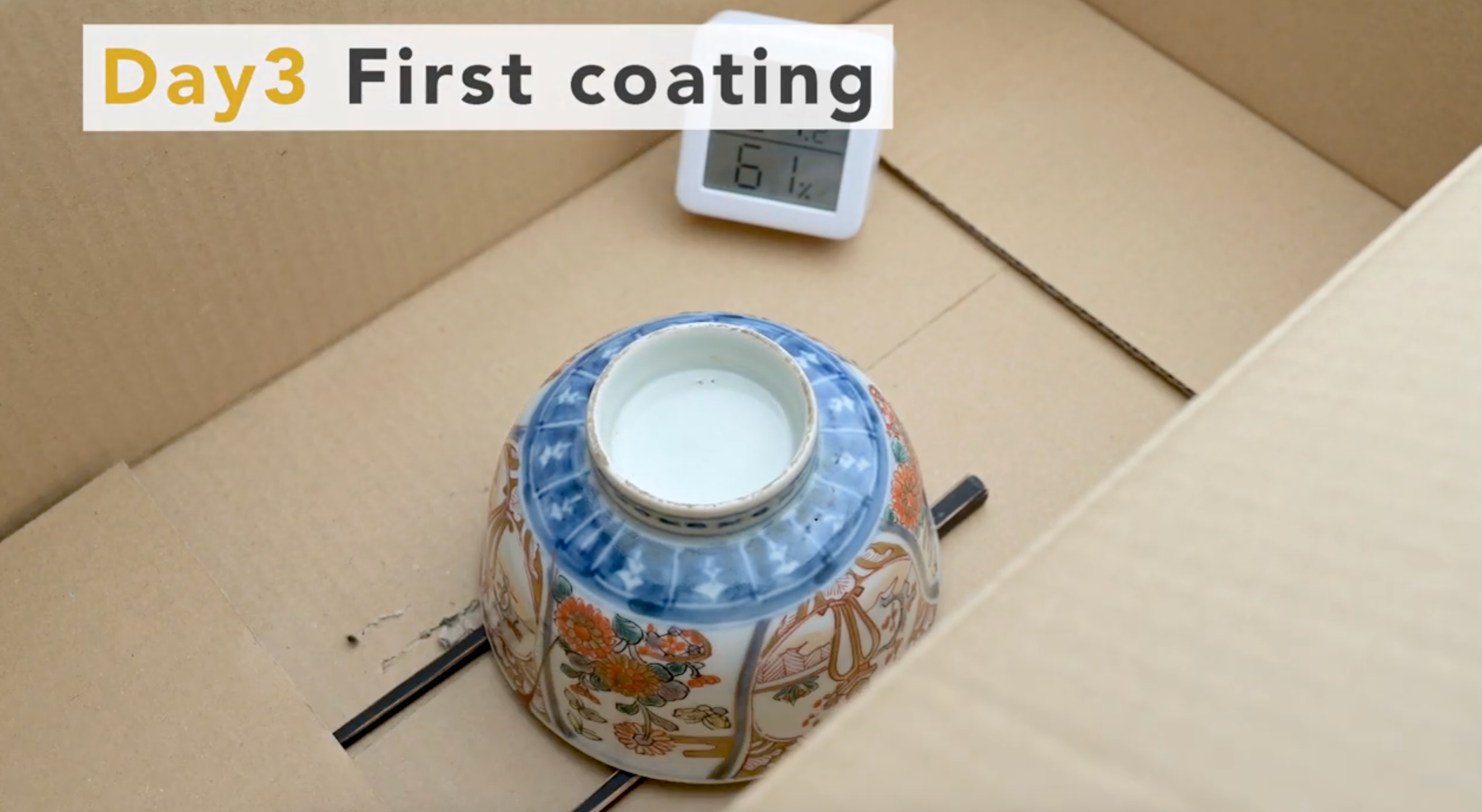
3. Wait few days to harden
When you have finished coating, leave it in the humid room and wait for a few days.
Since urushi on the chipped area may droop due to gravity, it should be stored in an orientation where drooping is not a problem.
Also, keep the temperature around 25°C and the humidity around 70% because it will not harden if the temperature and humidity is too low.
On the other hand, too high a humidity of 80% or more is not good, as it may cause wrinkles when the urushi hardens.
- note
- One method is to place wet towels in cardboard boxes to maintain the right humidity for storage.
- The temperature should also be kept from getting cold by using air conditioning.
- In particular, urushi may not harden properly if the temperature falls below 20 degrees Celsius, so be careful to control both temperature and humidity after working on this and subsequent steps.
1. Scrape off the sabi-urushi
After the sabi-urushi has hardened, scrape off it on the overhangs with a cutter to make the seams flat and even.
If the chipped surface is large and difficult to smooth with a cutter, use a sandpaper to smooth the surface as much as possible.
Wipe off any dirt on the surface of the ceramics with an ethanol-soaked tissue as appropriate.
2. Coating the seams with "Bengara urushi"
Once the seams are flatten, coat the seams with "Bengara urushi".
Wipe the brush tip thoroughly with ethanol first before use.
It is recommended to apply the inside first because if you apply the outside first, you may touch the seam when applying the inside.
The purpose of this process is not to simply coat the seams, but to fill in the small dents by pouring bengara urushi into the seams to further flatten the surface.
Work as if you were "filling in the gaps with urushi" rather than "applying urushi".
Apply so that the surface is this smooth.
3. Wait few days to harden
When you have finished coating, leave it in the humid room and wait for a few days.
Since urushi on the chipped area may droop due to gravity, it should be stored in an orientation where drooping is not a problem.
Also, keep the temperature around 25°C and the humidity around 70% because it will not harden if the temperature and humidity is too low.
On the other hand, too high a humidity of 80% or more is not good, as it may cause wrinkles when the urushi hardens.
- note
- One method is to place wet towels in cardboard boxes to maintain the right humidity for storage.
- The temperature should also be kept from getting cold by using air conditioning.
- In particular, urushi may not harden properly if the temperature falls below 20 degrees Celsius, so be careful to control both temperature and humidity after working on this and subsequent steps.



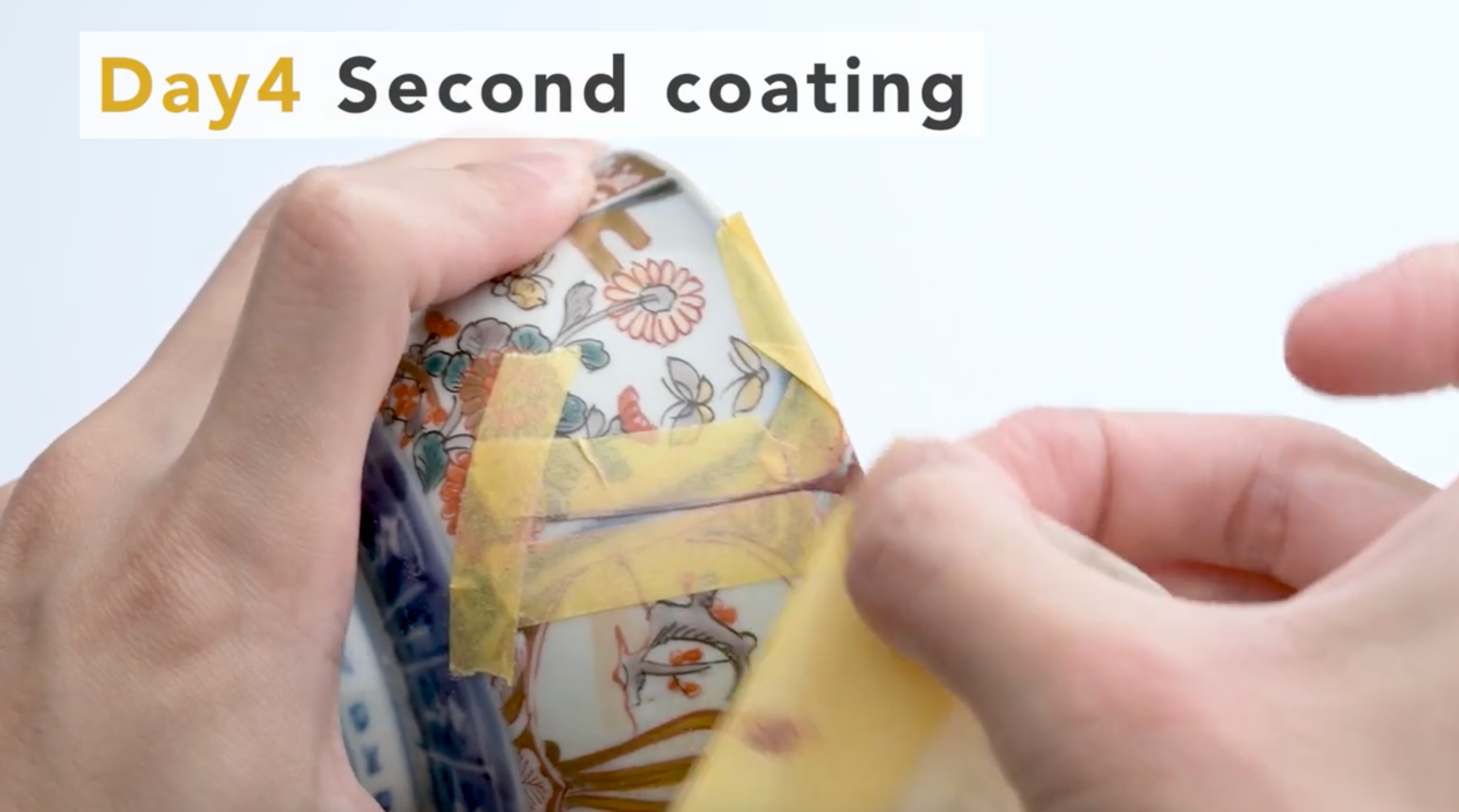
1. Polish the seams with an abrasive sheets
After the first coat of bengara urushi dries, polish the seams using soft abrasive sheets.
The polishing sheet is soft and fine-grained, so it will not scratch the glaze even if it is polished directly.
However, the gilding and painting may come off, so protect it with masking tape beforehand.
When the seams are flat enough that you can run your finger over them and not feel any bumps, wipe with ethanol.
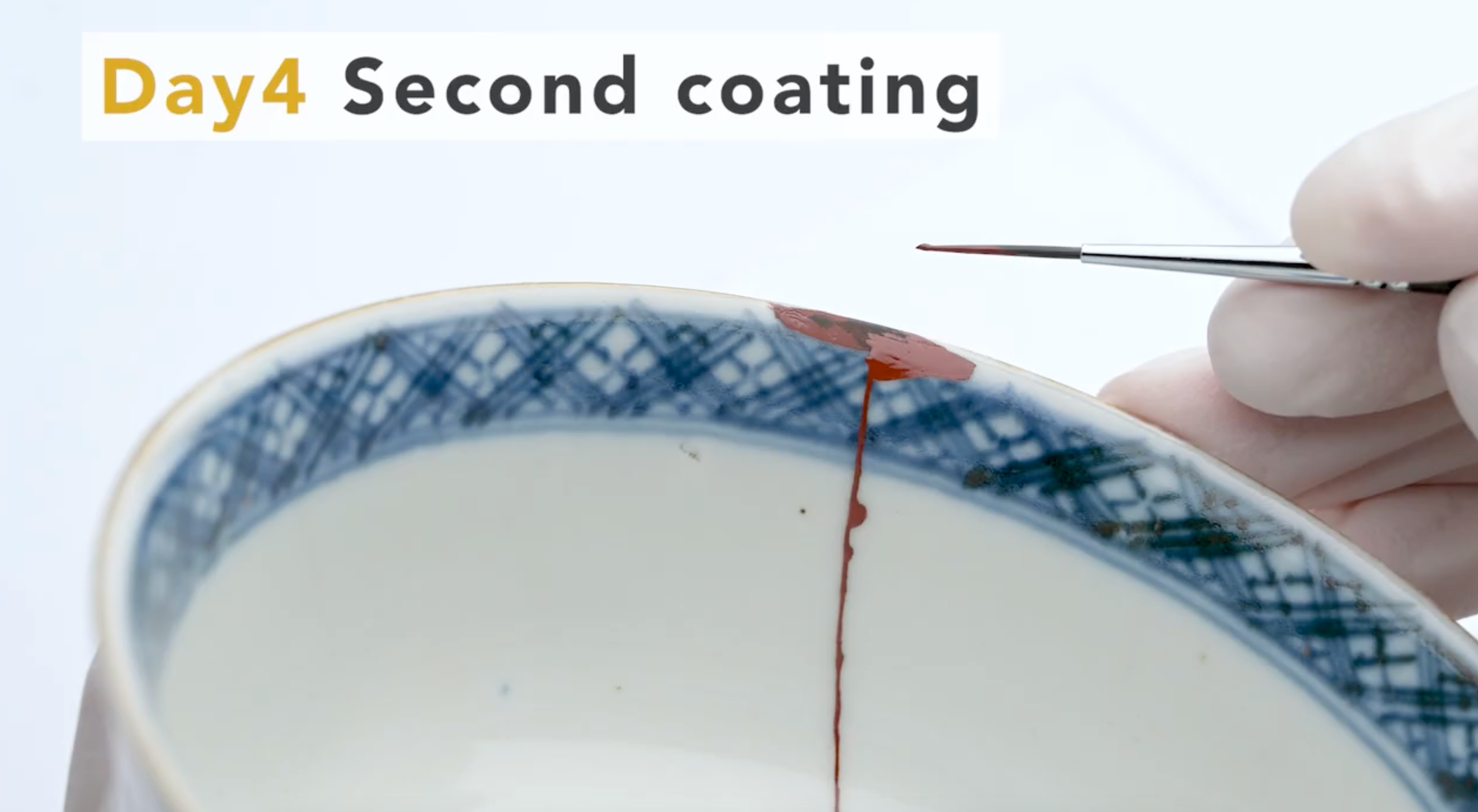
2. Coating with bengara urushi
Once polished, in many cases grooves and wrinkles still remain.
In such cases, coat the surface again using the same procedure as step 4.
Wipe the brush tip thoroughly with ethanol first before use.
When you have finished coating, leave it in the humid and warm place and wait for a few days.
- Tips
- In this procedure, the coating process has been applied twice, but basically the coating process is repeated until the seams are flat. Conversely, if the work is finished beautifully at the point of the first coat, the 2nd coat may not be applied.
1. Polish the seams with an abrasive sheets
After the first coat of bengara urushi dries, polish the seams using soft abrasive sheets.
The polishing sheet is soft and fine-grained, so it will not scratch the glaze even if it is polished directly.
However, the gilding and painting may come off, so protect it with masking tape beforehand.
When the seams are flat enough that you can run your finger over them and not feel any bumps, wipe with ethanol.
2. Coating with bengara urushi
Once polished, in many cases grooves and wrinkles still remain.
In such cases, coat the surface again using the same procedure as step 4.
Wipe the brush tip thoroughly with ethanol first before use.
When you have finished coating, leave it in the humid and warm place and wait for a few days.
- Tips
- In this procedure, the coating process has been applied twice, but basically the coating process is repeated until the seams are flat. Conversely, if the work is finished beautifully at the point of the first coat, the 2nd coat may not be applied.



1. Polish the seams with an abrasive sheet
After the 2nd coat of bengara urushi dries, polish the seams using an abrasive sheet.
The polishing sheet is soft and fine-grained, so it will not scratch the glaze even if it is polished directly.
However, the painting may come off, so protect it with masking tape beforehand.
When the seams are flat enough that you can run your finger over them and not feel any bumps, wipe the whole thing down with ethanol.

2. Apply a thin coat of Bengara-urushi
Once the seams are in place, it is time to prepare for applying gold powder.
First, a "thin" layer of bengara-urushi is applied to the seams.
Be careful not to apply it too thickly, otherwise the gold powder will sink into the bengara urushi.
- Tips for applying thin coat
- Put a little bengara urushi on the brush tip.
- Move the brush slowly.
- Do not add more bengara urushi until the bengara urushi becomes faint.
If you add bengara urushi to the tip frequently, it will be applied too thickly.
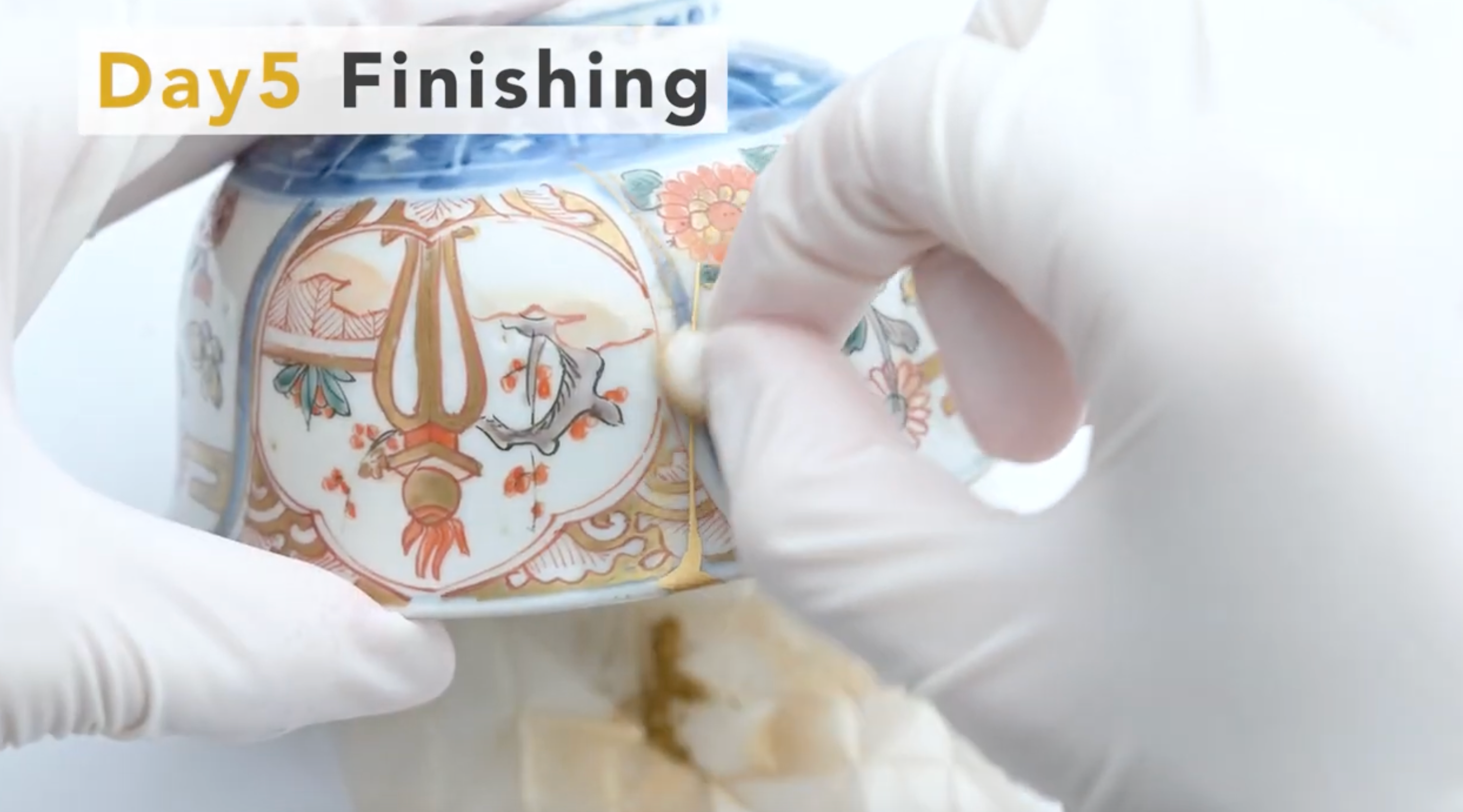
3. Apply gold powder on the seams
After applying bengara-urushi, apply gold powder.
First, put generous amount of gold powder on a cotton ball.
Then move the cotton ball in small circles over the seams.
- Tips
- Be careful that the cotton itself does not touch urushi.
- Ideally, only the gold powder on the cotton should touch the urushi.
- The key is to apply gently and with as little force as possible.
After the entire surface has been applied with gold powder, add more gold powder on the cotton ball, and move the cotton ball around the seams to apply it in a spaceless way.
This will give it more luster.
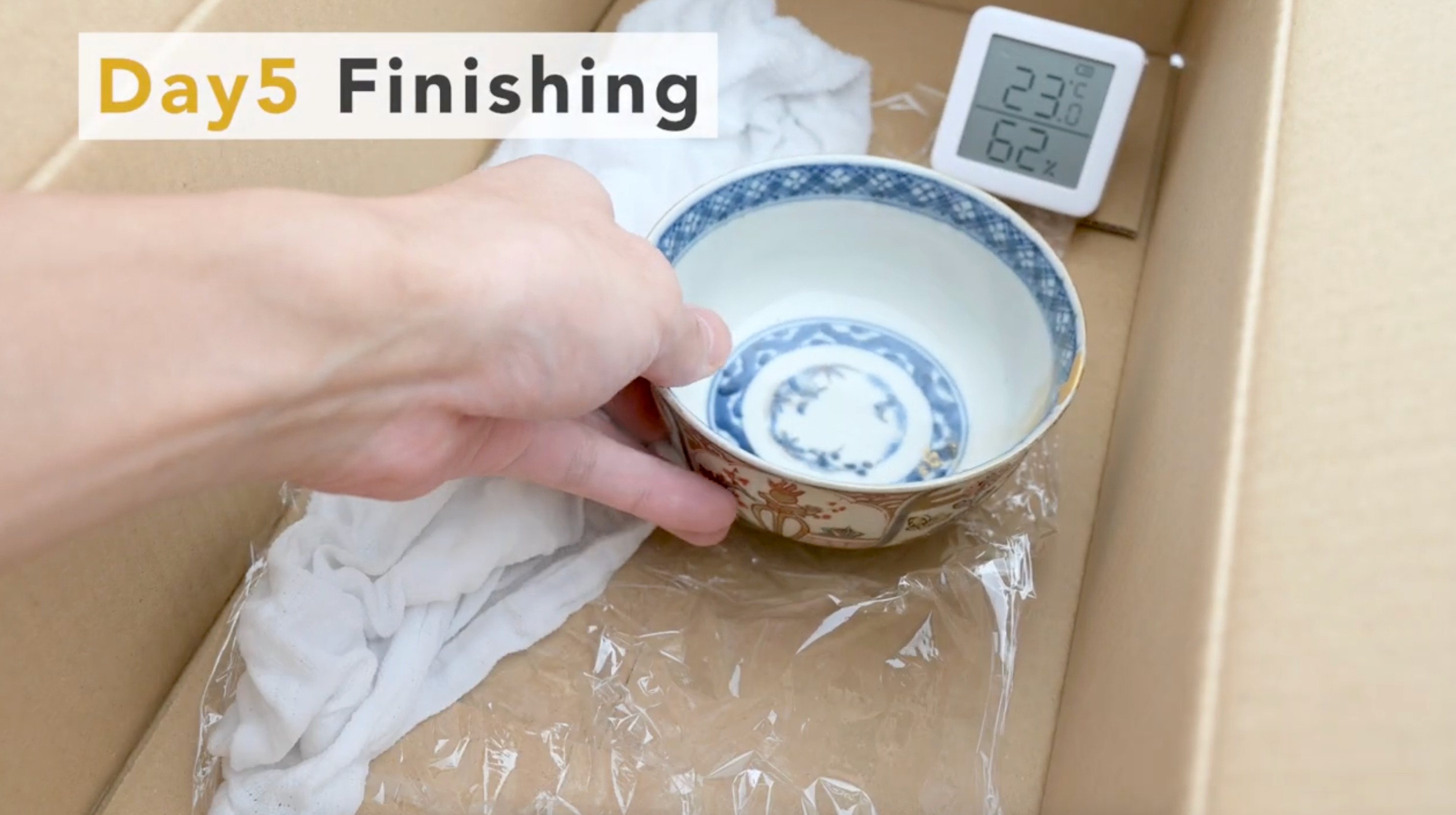
When you have finished applying, leave it in the humid room and wait for a few days.
Also, keep the temperature around 25°C and the humidity around 70% because it will not harden if the temperature and humidity is too low.
On the other hand, too high a humidity of 80% or more is not good, as it may cause wrinkles when the urushi hardens.
- note
- One method is to place wet towels in cardboard boxes to maintain the right humidity for storage.
- The temperature should also be kept from getting cold by using air conditioning.
- In particular, urushi may not harden properly if the temperature falls below 20 degrees Celsius, so be careful to control both temperature and humidity after working on this and subsequent steps.

4. Completion
After one to two weeks in the urushi room, the bengara urushi hardens and the gold powder is fixed to the seams.
Wipe off the surface with a wet wipe to complete the process.
At this time, wipe with water, not ethanol.
Wiping with ethanol may remove even gold powder.
1. Polish the seams with an abrasive sheet
After the 2nd coat of bengara urushi dries, polish the seams using an abrasive sheet.
The polishing sheet is soft and fine-grained, so it will not scratch the glaze even if it is polished directly.
However, the painting may come off, so protect it with masking tape beforehand.
When the seams are flat enough that you can run your finger over them and not feel any bumps, wipe the whole thing down with ethanol.
2. Apply a thin coat of Bengara-urushi
Once the seams are in place, it is time to prepare for applying gold powder.
First, a "thin" layer of bengara-urushi is applied to the seams.
Be careful not to apply it too thickly, otherwise the gold powder will sink into the bengara urushi.
- Tips for applying thin coat
- Put a little bengara urushi on the brush tip.
- Move the brush slowly.
- Do not add more bengara urushi until the bengara urushi becomes faint.
If you add bengara urushi to the tip frequently, it will be applied too thickly.
3. Apply gold powder on the seams
After applying bengara-urushi, apply gold powder.
First, put generous amount of gold powder on a cotton ball.
Then move the cotton ball in small circles over the seams.
- Tips
- Be careful that the cotton itself does not touch urushi.
- Ideally, only the gold powder on the cotton should touch the urushi.
- The key is to apply gently and with as little force as possible.
After the entire surface has been applied with gold powder, add more gold powder on the cotton ball, and move the cotton ball around the seams to apply it in a spaceless way.
This will give it more luster.
When you have finished applying, leave it in the humid room and wait for a few days.
Also, keep the temperature around 25°C and the humidity around 70% because it will not harden if the temperature and humidity is too low.
On the other hand, too high a humidity of 80% or more is not good, as it may cause wrinkles when the urushi hardens.
- note
- One method is to place wet towels in cardboard boxes to maintain the right humidity for storage.
- The temperature should also be kept from getting cold by using air conditioning.
- In particular, urushi may not harden properly if the temperature falls below 20 degrees Celsius, so be careful to control both temperature and humidity after working on this and subsequent steps.
4. Completion
After one to two weeks in the urushi room, the bengara urushi hardens and the gold powder is fixed to the seams.
Wipe off the surface with a wet wipe to complete the process.
At this time, wipe with water, not ethanol.
Wiping with ethanol may remove even gold powder.





Basic Kit
Lesson 03: Cracked
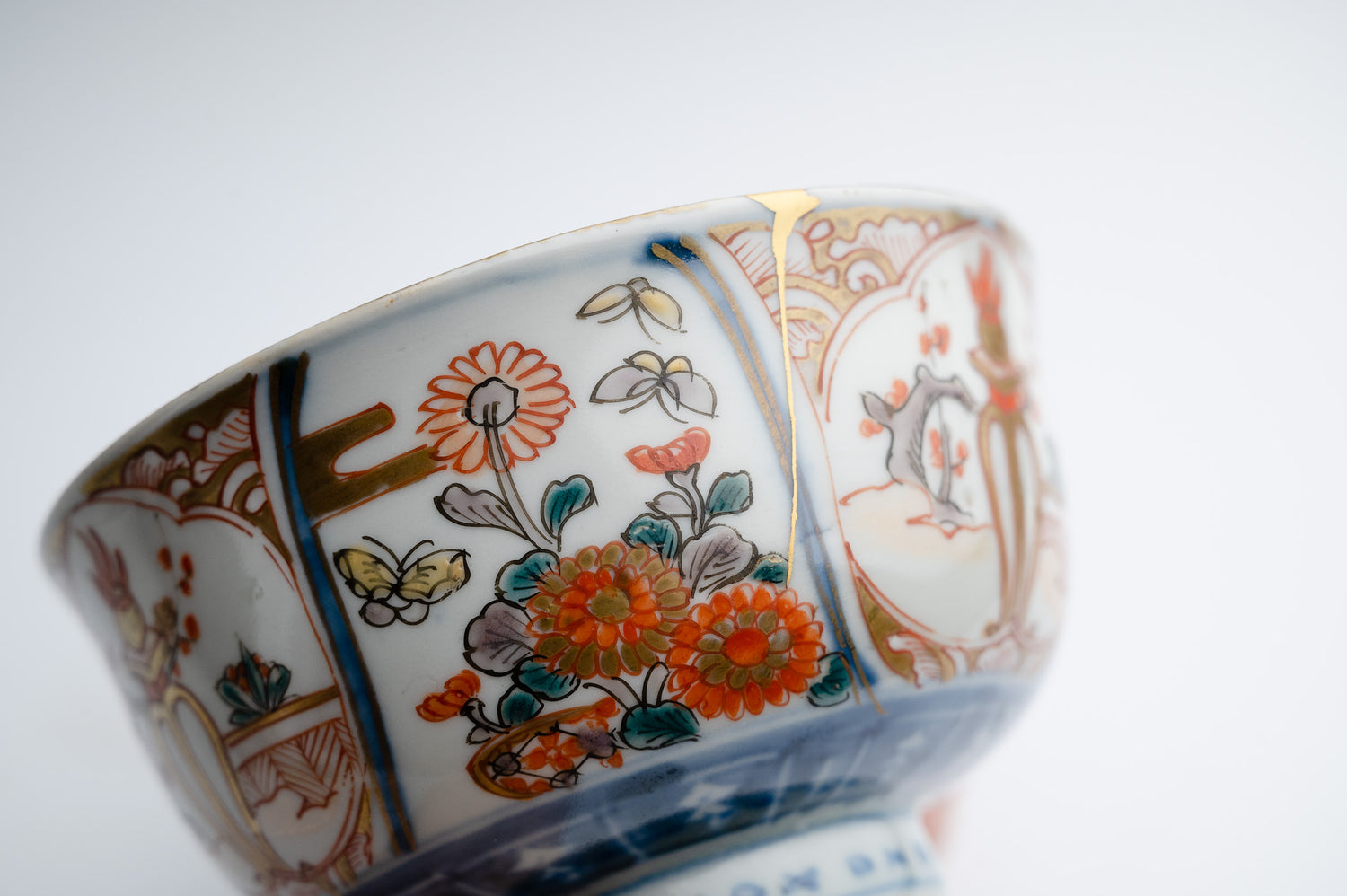
Leave a comment
All comments are moderated before being published.
This site is protected by reCAPTCHA and the Google Privacy Policy and Terms of Service apply.